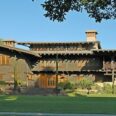
Donald V. Helmberger, who ran the Caltech Seismological Laboratory from 1998 to 2003, passed away on August 13 at the age of 82.
Helmberger, Smits Family Professor of Geophysics, Emeritus, was born on January 23, 1938. He grew up in Perham, Minnesota, and earned his bachelor’s degree from the University of Minnesota in 1961. During his undergraduate studies, he connected with alumnus George Shor (BS ’44, MS ’48, PhD ’54) of the Scripps Institution of Oceanography, who took Helmberger on a research cruise to Alaska in the summer of 1961 to conduct seismic studies of the oceanic crust in the Bering Sea. This first foray into seismology research changed the course of Helmberger’s academic career: although he was originally interested in physics, he shifted his focus to geophysics when he entered graduate school at UC San Diego. He earned a master’s degree in 1965 and a doctorate degree in 1967.
After he earned his PhD, Helmberger took a position as a research associate at MIT and then worked as an assistant professor at Princeton University. He returned to California when he was offered a job in the Caltech Seismological Laboratory by Don Anderson, the lab’s director from 1967 to 1989; Helmberger recalled in a 1999 oral history that he was intrigued by the Seismological Laboratory because it was one of only two places at the time that maintained large earthquake catalogs.
Helmberger joined the Caltech faculty as an assistant professor in 1970, became an associate professor in 1974, and a full professor in 1979. In 2000, he was named Smits Family Professor of Geophysics.
On the morning of February 9, 1971, the magnitude-6.5 San Fernando earthquake shook him out of his bed in Altadena. The event kindled his interest in modeling earthquakes to understand the physical forces that drive them. At the time, earthquake models typically focused on long-period seismological waves, which reveal how Earth vibrates as a whole. Helmberger and his colleagues pioneered the development of models based on the short-period waves that actually cause damage. These models revealed details about the earthquake itself, such as the complexity of the fault rupture and its depth below ground.
Helmberger’s primary research interests involved seismic-wave propagation and the use of waveforms to recover information about earthquake characteristics as well as the earth’s structure. He discovered ultralow velocity zones (ULVZs), which are unusual masses that lurk at the base of the earth’s mantle, just above the core. ULVZs, which are so-named because they significantly slow the seismic waves that pass through them, have been observed under the Pacific Rim, North America, Europe, and Africa.
In 1997, Helmberger became the first recipient of the American Geophysical Union’s Inge Lehmann Medal, and he was named to the National Academy of Sciences in 2004. He became an emeritus professor in 2017.
A full obituary will follow.














 0 comments
0 comments


